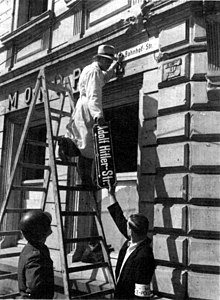
Back اجتثاث النازية Arabic Nasizmdən təmizlənmə Azerbaijani Дэнацыфікацыя Byelorussian Дэнацыфікацыя BE-X-OLD Денацификация Bulgarian Desnazificació Catalan Denacifikace Czech Afnazificering Danish Entnazifizierung German Sennaziigo Esperanto

| Part of a series on |
| Nazism |
|---|
| Part of a series on |
| Fascism |
|---|
 |
Denazification (German: Entnazifizierung) was an Allied initiative to rid German and Austrian society, culture, press, economy, judiciary, and politics of the Nazi ideology following the Second World War. It was carried out by removing those who had been Nazi Party or SS members from positions of power and influence, by disbanding or rendering impotent the organizations associated with Nazism, and by trying prominent Nazis for war crimes in the Nuremberg trials of 1946. The program of denazification was launched after the end of the war and was solidified by the Potsdam Agreement in August 1945. The term denazification was first coined as a legal term in 1943 by the U.S. Pentagon, intended to be applied in a narrow sense with reference to the post-war German legal system. However, it later took on a broader meaning.[1]
In late 1945 and early 1946, the emergence of the Cold War and the economic importance of Germany caused the United States in particular to lose interest in the program, somewhat mirroring the Reverse Course in American-occupied Japan. The British handed over denazification panels to the Germans in January 1946, while the Americans did likewise in March 1946. The French ran the mildest denazification effort. Denazification was carried out in an increasingly lenient and lukewarm way until being officially abolished in 1951. Additionally, the program was hugely unpopular in West Germany, where many Nazis maintained positions of power. Denazification was opposed by the new West German government of Konrad Adenauer,[2] who declared that ending the process was necessary for West German rearmament.[citation needed] On the other hand, denazification in East Germany was considered a critical element of the transformation into a socialist society, and the country was stricter in opposing Nazism than its counterpart. However, not all former Nazis faced judgment. Doing special tasks for the occupation governments could protect Nazi members from prosecution, enabling them to continue working and in some cases reach prominence, as did special connections with the occupiers.[3] One of the most notable cases involved Wernher von Braun, who was among other German scientists recruited by the United States through Operation Paperclip and later occupied key positions in the American space program.[4][5][6][7]
- ^ Taylor, Frederick (2011). Exorcising Hitler: The Occupation and Denazification of Germany. Bloomsbury Publishing. pp. 253–254. ISBN 978-1408822128.
- ^ Goda, Norman J. W. (2007). Tales from Spandau: Nazi Criminals and the Cold War. Cambridge: Cambridge University Press. pp. 101–149. ISBN 978-0-521-86720-7.
- ^ Taylor (2011), p. 256.
- ^ Jacobsen, Annie (2014). Operation Paperclip: The Secret Intelligence Program that Brought Nazi Scientists to America. bpb.
- ^ Benz, Wolfgang (2005). Demokratisierung durch Entnazifizierung und Erziehung. bpb. p. 7.
- ^ Sperk, Alexander (2003). Entnazifizierung und Personalpolitik in der sowjetischen Besatzungszone Köthen/Anhalt. Eine Vergleichsstudie (1945–1948) [Denazification and personal politics in the Soviet Occupied Zone of Köthen/Anhalt. A comparative study (1945–1948).] (in German). Dößel: Verlag Janos Stekovics. ISBN 3-89923-027-2.
- ^ Kai Cornelius, Vom spurlosen Verschwindenlassen zur Benachrichtigungspflicht bei Festnahmen, BWV Verlag, 2004, pp. 126ff, ISBN 3-8305-1165-5
© MMXXIII Rich X Search. We shall prevail. All rights reserved. Rich X Search